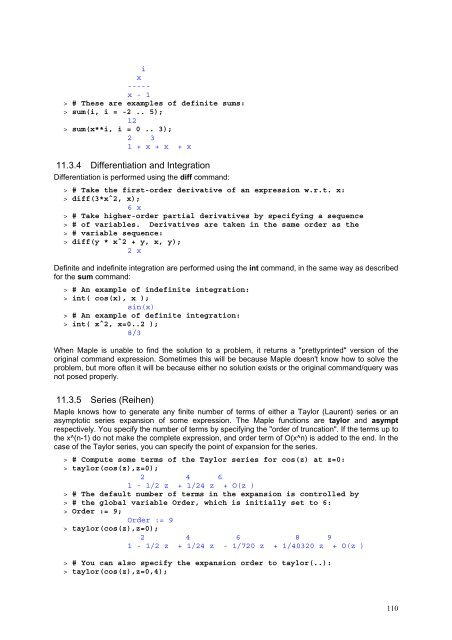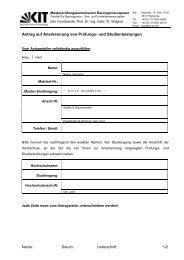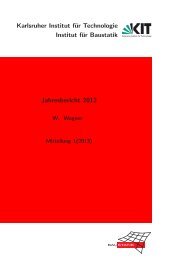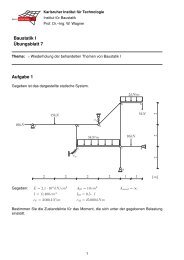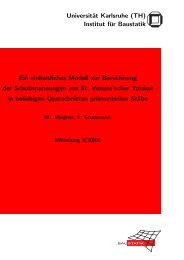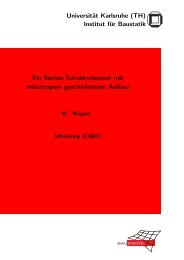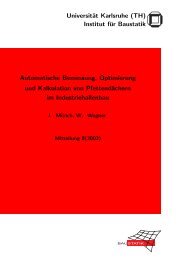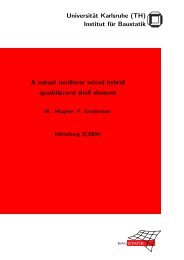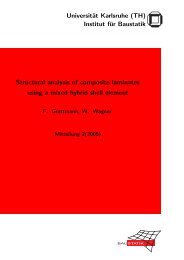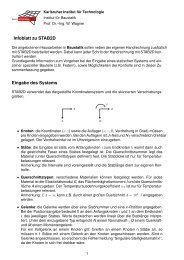PDF-Version - am Institut für Baustatik
PDF-Version - am Institut für Baustatik
PDF-Version - am Institut für Baustatik
Sie wollen auch ein ePaper? Erhöhen Sie die Reichweite Ihrer Titel.
YUMPU macht aus Druck-PDFs automatisch weboptimierte ePaper, die Google liebt.
i<br />
x<br />
-----<br />
x - 1<br />
> # These are ex<strong>am</strong>ples of definite sums:<br />
> sum(i, i = -2 .. 5);<br />
12<br />
> sum(x**i, i = 0 .. 3);<br />
2 3<br />
1 + x + x + x<br />
11.3.4 Differentiation and Integration<br />
Differentiation is performed using the diff command:<br />
> # Take the first-order derivative of an expression w.r.t. x:<br />
> diff(3*x^2, x);<br />
6 x<br />
> # Take higher-order partial derivatives by specifying a sequence<br />
> # of variables. Derivatives are taken in the s<strong>am</strong>e order as the<br />
> # variable sequence:<br />
> diff(y * x^2 + y, x, y);<br />
2 x<br />
Definite and indefinite integration are performed using the int command, in the s<strong>am</strong>e way as described<br />
for the sum command:<br />
> # An ex<strong>am</strong>ple of indefinite integration:<br />
> int( cos(x), x );<br />
sin(x)<br />
> # An ex<strong>am</strong>ple of definite integration:<br />
> int( x^2, x=0..2 );<br />
8/3<br />
When Maple is unable to find the solution to a problem, it returns a "prettyprinted" version of the<br />
original command expression. Sometimes this will be because Maple doesn't know how to solve the<br />
problem, but more often it will be because either no solution exists or the original command/query was<br />
not posed properly.<br />
11.3.5 Series (Reihen)<br />
Maple knows how to generate any finite number of terms of either a Taylor (Laurent) series or an<br />
asymptotic series expansion of some expression. The Maple functions are taylor and asympt<br />
respectively. You specify the number of terms by specifying the "order of truncation". If the terms up to<br />
the x^(n-1) do not make the complete expression, and order term of O(x^n) is added to the end. In the<br />
case of the Taylor series, you can specify the point of expansion for the series.<br />
> # Compute some terms of the Taylor series for cos(z) at z=0:<br />
> taylor(cos(z),z=0);<br />
2 4 6<br />
1 - 1/2 z + 1/24 z + O(z )<br />
> # The default number of terms in the expansion is controlled by<br />
> # the global variable Order, which is initially set to 6:<br />
> Order := 9;<br />
Order := 9<br />
> taylor(cos(z),z=0);<br />
2 4 6 8 9<br />
1 - 1/2 z + 1/24 z - 1/720 z + 1/40320 z + O(z )<br />
> # You can also specify the expansion order to taylor(..):<br />
> taylor(cos(z),z=0,4);<br />
110


